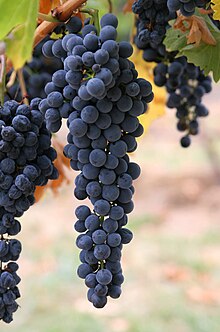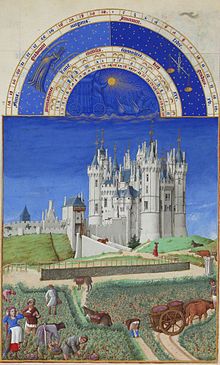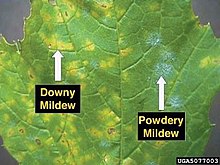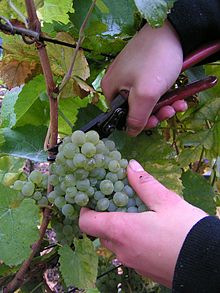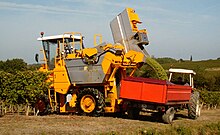
Chardonnay is a green-skinned grape variety used in the production of white wine. The variety originated in the Burgundy wine region of eastern France, but is now grown wherever wine is produced, from England to New Zealand. For new and developing wine regions, growing Chardonnay is seen as a 'rite of passage' and an easy entry into the international wine market.

Cabernet Sauvignon is one of the world's most widely recognized red wine grape varieties. It is grown in nearly every major wine producing country among a diverse spectrum of climates from Australia and British Columbia, Canada to Lebanon's Beqaa Valley. Cabernet Sauvignon became internationally recognized through its prominence in Bordeaux wines, where it is often blended with Merlot and Cabernet Franc. From France and Spain, the grape spread across Europe and to the New World where it found new homes in places like California's Napa Valley, New Zealand's Hawke's Bay, South Africa's Stellenbosch region, Australia's Margaret River, McLaren Vale and Coonawarra regions, and Chile's Maipo Valley and Colchagua. For most of the 20th century, it was the world's most widely planted premium red wine grape until it was surpassed by Merlot in the 1990s. However, by 2015, Cabernet Sauvignon had once again become the most widely planted wine grape, with a total of 341,000 hectares (3,410 km2) under vine worldwide.

Sauvignon blanc is a green-skinned grape variety that originates from the city of Bordeaux in France. The grape most likely gets its name from the French words sauvage ("wild") and blanc ("white") due to its early origins as an indigenous grape in South West France. It is possibly a descendant of Savagnin. Sauvignon blanc is planted in many of the world's wine regions, producing a crisp, dry, and refreshing white varietal wine. The grape is also a component of the famous dessert wines from Sauternes and Barsac. Sauvignon blanc is widely cultivated in France, Chile, Romania, Canada, Australia, New Zealand, South Africa, Bulgaria, the states of Oregon, Washington, and California in the US. Some New World Sauvignon blancs, particularly from California, may also be called "Fumé Blanc", a marketing term coined by Robert Mondavi in reference to Pouilly-Fumé.

Zinfandel is a variety of black-skinned wine grape. The variety is grown in over 10 percent of California vineyards. DNA analysis has revealed that it is genetically equivalent to the Croatian grapes Crljenak Kaštelanski and Tribidrag, as well as to the Primitivo variety traditionally grown in Apulia, Italy, where it was introduced in the 18th century, and Kratošija in Montenegro. The grape found its way to the United States in the mid-19th century, where it became known by variations of a name applied to a different grape, likely "Zierfandler" from Austria.

Aurore is a white complex hybrid grape variety produced by Albert Seibel and used for wine production mostly in the United States and Canada. Over a long lifetime Seibel produced many complex hybrid crosses of Vitis vinifera to American grapes. It is a cross of Seibel 788 and Seibel 29.
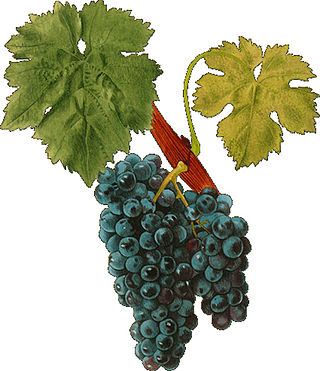
Carignan is a red grape variety of Spanish origin that is more commonly found in French wine but is widely planted throughout the western Mediterranean and around the globe. Along with Aramon, it was considered one of the main grapes responsible for France's wine lake and was a substantial producer in jug wine production in California's Central Valley but in recent years, it has been reborn as a flagship wine for many cellars in the south of France as well as in Catalonia.

Vitis vinifera, the common grape vine, is a species of flowering plant, native to the Mediterranean region, Central Europe, and southwestern Asia, from Morocco and Portugal north to southern Germany and east to northern Iran. There are currently between 5,000 and 10,000 varieties of Vitis vinifera grapes though only a few are of commercial significance for wine and table grape production.

Mosel is one of 13 German wine regions (Weinbaugebiete) for quality wines , and takes its name from the Mosel River. Before 1 August 2007 the region was called Mosel-Saar-Ruwer, but changed to a name that was considered more consumer-friendly. The wine region is Germany's third largest in terms of production but some consider it the leading region in terms of international prestige.

Mourvèdre is a red wine grape variety grown in many regions around the world including the Rhône and Provence regions of France, the Valencia and Jumilla and Yecla denominaciones de origen (DOs) of Spain, as well as the Balearic Islands, California and Washington and the Australian regions of South Australia and New South Wales, plus South Africa. In addition to making red varietal wines, Mourvèdre is a prominent component in "GSM" blends. The variety is also used to make rosé and port-style fortified wines.

Côte-Rôtie is a French wine Appellation d'origine contrôlée (AOC) in the northern Rhône wine region of France. The vineyards are located just south of Vienne in the communes of Saint-Cyr-sur-le-Rhône, Ampuis, and Tupin-et-Semons. The vineyards are unique because of the steep slopes facing the river and their stone walls. Côte-Rôtie can be rendered in English as "the roasted slope" and refers to the long hours of sunlight that these steep slopes receive.
South African wine has a history dating back to 1659 with the first bottle being produced in Cape Town by its founder and governor Jan van Riebeeck. Access to international markets led to new investment in the South African wine market. Production is concentrated around Cape Town and almost exclusively located within the Western Cape province, with major vineyard and production centres at Constantia, Paarl, Stellenbosch and Worcester.

Washington wine is a wine produced from grape varieties grown in the U.S. state of Washington. Washington ranks second in the United States in the production of wine. By 2017, the state had over 55,000 acres (220 km2) of vineyards, a harvest of 229,000 short tons (208,000 t) of grapes, and exports going to over 40 countries around the world from the 940+ wineries located in the state. While there are some viticultural activities in the cooler, wetter western half of the state, the majority (99.9%) of wine grape production takes place in the shrub-steppe eastern half. The rain shadow of the Cascade Range leaves the Columbia River Basin with around 8 inches (200 mm) of annual rain fall, making irrigation and water rights of paramount interest to the Washington wine industry. Viticulture in the state is also influenced by long sunlight hours and consistent temperatures.

Ancient Rome played a pivotal role in the history of wine. The earliest influences on the viticulture of the Italian peninsula can be traced to ancient Greeks and the Etruscans. The rise of the Roman Empire saw both technological advances in and burgeoning awareness of winemaking, which spread to all parts of the empire. Rome's influence has had a profound effect on the histories of today's major winemaking regions in France, Germany, Italy, Portugal and Spain.

Corsica wine is wine made on the Mediterranean island of Corsica. Located 90 km west of Italy, 170 km southeast of France and 11 km north of the island of Sardinia, the island is a territorial collectivity of France, but many of the region's winemaking traditions and its grape varieties are Italian in origin. The region's viticultural history can be traced to the island's settlement by Phoceans traders in 570 BC in what is now the commune of Aléria. In the 18th century, the island came under the control of France. Following the independence of Algeria from French rule, many Algerian Pieds-Noirs immigrated to Corsica and began planting vineyards. Between 1960 and 1976 the vineyard area in Corsica increased fourfold. In 1968, Patrimonio was established as Corsica's first Appellation d'origine contrôlée (AOC). Today, Corsica has nine AOC regions including the island-wide designation Vin de Corse AOC. The majority of the wine exported from Corsica falls under the Vin de pays designation Vin de Pays de l'Île de Beauté. The three leading grape varieties of the region are Nielluccio (Sangiovese), known as the spice wine of France, Sciacarello and Vermentino.
Precision viticulture is precision farming applied to optimize vineyard performance, in particular maximizing grape yield and quality while minimizing environmental impacts and risk. This is accomplished by measuring local variation in factors that influence grape yield and quality and applying appropriate viticulture management practices. Precision viticulture is based on the premise that high in-field variability for factors that affect vine growth and grape ripening warrants intensive management customized according to local conditions. Precision viticulture depends on new and emerging technologies such as global positioning systems (GPS), meteorologic and other environmental sensors, satellite and airborne remote sensing, and geographic information systems (GIS) to assess and respond to variability.
This glossary of viticultural terms list some of terms and definitions involved in growing grapes for use in winemaking.

In viticulture, ripeness is the completion of the ripening process of wine grapes on the vine which signals the beginning of harvest. What exactly constitutes ripeness will vary depending on what style of wine is being produced and what the winemaker and viticulturist personally believe constitutes ripeness. Once the grapes are harvested, the physical and chemical components of the grape which will influence a wine's quality are essentially set so determining the optimal moment of ripeness for harvest may be considered the most crucial decision in winemaking.

Irrigation in viticulture is the process of applying extra water in the cultivation of grapevines. It is considered both controversial and essential to wine production. In the physiology of the grapevine, the amount of available water affects photosynthesis and hence growth, as well as the development of grape berries. While climate and humidity play important roles, a typical grape vine needs 25-35 inches of water a year, occurring during the spring and summer months of the growing season, to avoid stress. A vine that does not receive the necessary amount of water will have its growth altered in a number of ways; some effects of water stress are considered desirable by wine grape growers.

The Barossa Valley wine region is one of Australia's oldest and most premier wine regions. Located in South Australia, the Barossa Valley is about 56 km northeast of the city of Adelaide. Unlike most of Australia whose wine industry was heavily influenced by the British, the wine industry of the Barossa Valley was founded by German settlers fleeing persecution from the Prussian province of Silesia. The warm continental climate of the region promoted the production of very ripe grapes that was the linchpin of the early Australian fortified wine industry. As the modern Australian wine industry shifted towards red table wines in the mid-20th century, the Barossa Valley fell out of favor due to its reputation for being largely a Syrah from producers whose grapes were destined for blending. During this period the name "Barossa Valley" rarely appeared on wine labels. In the 1980s, the emergence of several boutique families specializing in old vine Shiraz wines began to capture international attention for the distinctive style of Barossa Shiraz, a full bodied red wine with rich chocolate and spice notes. This led to a renaissance in the Barossa Valley which catapulted the region to the forefront of the Australian wine industry.
Cascade is a red complex hybrid grape variety that was created by French viticulturist Albert Seibel in the early 20th century in Aubenas, Ardèche, in the Rhône Valley. It has been commercially available in North America since 1938 and has since been planted in Canada and the United States. However, in warmer climates the grape is highly susceptible to a number of grapevine viruses, which has discouraged plantings of the variety.
